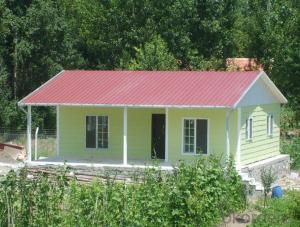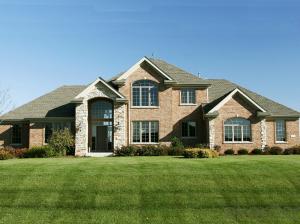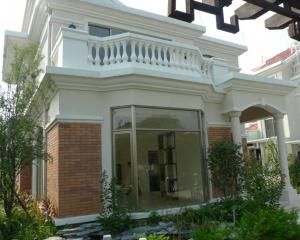Good Quality Mobile House Made in China
- Loading Port:
- China Main Port
- Payment Terms:
- TT OR LC
- Min Order Qty:
- -
- Supply Capability:
- -
OKorder Service Pledge
OKorder Financial Service
You Might Also Like
prefabricated steel building Feature:
* Prefabrication, easy to install and disassemble
* Precision works, long life-span up to 15 years for use
* Lightness, easy to transport and relocate
* Using several times and recycling, economy and environment friendly
Prefab house Main material list as following:
Wall: 50mm/75mm thick EPS/Rockwool/PU sandwich panel
Roof: 50mm/75mm thick EPS/Rockwool/PU corrugated sandwich panel
Window: UPVC or Aluminum sliding window
Door: aluminum frame with panel same as wall panels(security door as optional)
Prefab house Joint material: steel column/aluminum alloy
1. Free from the damages by inspects, such as white ants and so on
2. Steel code: Q345, Q235
3. Designed life span: more than 30 years;
4. Green and environment-friendly materials used;
5. Seismic resistance up to 8 magnitudes
6. Safe---Able to stands for maximum 55 m/s typhoon
7. Advanced roof and wall cladding material guarantee excellent acoustic insulation, less 65% energy consumption than the concrete structure.
8. Additional 10%-15% net area compared to the traditional building, air cavity between the cladding and main structure guarantees the comfortable indoor space.
Prefab house advantage
1. Easy and quick to install;
2. Excellent load and span capabilities;
3. Significant savings in site installation costs;
4. Panel comes in a range of aesthetically pleasuring colors;
5. Energy saving thermal insulation;
6. Superior air tightness for controlled environments;
7. Good reactions to fire properties;
8. Durable, long lasting, stood the test of time in the extremes of harsh climate
- Q:Can container houses be designed to have a guest room?
- Yes, container houses can be designed to have a guest room. The modular nature of container houses allows for flexibility in design, making it possible to include separate spaces for guests within the overall layout. Additional containers can be added or modified to create a comfortable and functional guest room, ensuring that visitors have a pleasant stay.
- Q:Are container houses fire-resistant?
- Container houses can be made fire-resistant, but it depends on the materials used during construction. The steel structure of shipping containers itself is fire-resistant to some extent, as steel is a non-combustible material. However, the interior and exterior finishes of the container house, such as insulation, cladding, and roofing, will determine the overall fire resistance. To enhance fire resistance, container houses can be constructed using fire-resistant materials like mineral wool insulation, which has a high resistance to fire. Additionally, fire-resistant cladding materials such as cement fiberboard or metal panels can be used to further protect the container house from fire risks. Fire-resistant roofing materials like metal or concrete can also be utilized to minimize the risk of fire spreading through the roof. It is important to note that while container houses can be made fire-resistant, it is crucial to follow building codes and regulations to ensure proper fire safety measures are implemented during construction. This may include the installation of fire alarms, smoke detectors, fire extinguishers, and adequate escape routes. Overall, with the use of appropriate materials and adherence to fire safety standards, container houses can be made fire-resistant, providing a safer living environment for its inhabitants.
- Q:Are container houses suitable for co-living or shared housing?
- Yes, container houses are suitable for co-living or shared housing. They can provide affordable and sustainable housing options for multiple individuals or families. With their compact design and modular nature, container houses can be easily customized and adapted to accommodate shared living spaces, ensuring privacy and comfort for each resident. Additionally, container houses can be easily transported and set up in various locations, making them a flexible solution for co-living communities or shared housing initiatives.
- Q:Are container houses suitable for cold climates?
- Container houses can indeed be suitable for cold climates when considering proper insulation and design. Although shipping containers are constructed from steel and conduct heat rapidly, they can be insulated and modified to withstand low temperatures. By incorporating top-quality insulation materials like spray foam or rigid foam into the walls, floors, and ceilings, the container can effectively retain heat. Furthermore, insulating the roof and utilizing double-glazed windows will enhance thermal performance and prevent heat loss. In cold climates, adequate ventilation is crucial to prevent condensation and maintain a healthy indoor environment. The installation of a ventilation system with heat recovery can retain warmth while exchanging stale indoor air for fresh outdoor air. Regarding design, it is essential to orient the container house in a way that maximizes natural sunlight and heat absorption. The inclusion of large windows on the southern side of the house can capture the sun's warmth during the day, reducing the need for additional heating. Additionally, incorporating passive solar design principles, such as thermal mass, can store and release heat throughout the day. It should be noted that container houses in cold climates may require supplementary heating sources like electric heaters, wood-burning stoves, or radiant floor heating to ensure sufficient warmth during extremely cold weather. However, with proper insulation, design considerations, and additional heating options, container houses can indeed be made suitable for cold climates.
- Q:Are container houses suitable for remote or off-grid workspaces?
- Yes, container houses are suitable for remote or off-grid workspaces. Container houses are designed to be portable and can be easily transported to remote locations. They are also customizable and can be equipped with various amenities required for a workspace, such as electricity, plumbing, insulation, and heating/cooling systems. Additionally, container houses are eco-friendly as they are made from recycled materials, making them a sustainable option for off-grid workspaces. They can be fitted with solar panels and rainwater harvesting systems to ensure a self-sufficient and sustainable workspace. Moreover, containers are durable and can withstand harsh weather conditions, making them ideal for remote locations. Overall, container houses offer a cost-effective, customizable, and sustainable solution for creating remote or off-grid workspaces.
- Q:Can container houses be designed with a built-in laundry room?
- Yes, container houses can definitely be designed with a built-in laundry room. The versatility and customizability of container homes allow for various design options, including the inclusion of a laundry room. By cleverly utilizing the available space within the container, architects and designers can create functional and efficient laundry rooms that fit seamlessly into the overall layout of the house. This can be achieved by incorporating space-saving features such as stackable or compact laundry appliances, innovative storage solutions, and smart design elements. Additionally, with proper planning and utilization of plumbing and electrical systems, container houses can easily accommodate the necessary connections and installations for a fully functional laundry room.
- Q:Are container houses suitable for remote working?
- Indeed, remote working can be facilitated by container houses. The advantages of container houses for remote workers are manifold, encompassing flexibility, affordability, and sustainability. To begin with, container houses offer a great deal of flexibility, as they can be tailored to meet the specific requirements of remote workers. The interior can be designed in a manner that accommodates a dedicated workspace, complete with essential amenities such as a desk, chair, and storage for office supplies. Furthermore, containers can be easily adapted to include windows and skylights, guaranteeing adequate lighting and ventilation for a comfortable work atmosphere. Moreover, container houses are often more cost-effective compared to conventional houses or office spaces. The expense associated with purchasing and converting a container into a home office is generally lower than that of constructing or renting a separate office space. This affordability makes container houses an appealing option for remote workers seeking to reduce expenses and allocate their resources more efficiently. Lastly, container houses are renowned for their sustainability. Typically constructed from recycled materials, they have a reduced environmental impact in comparison to traditional construction methods. By opting for a container house for remote working, individuals can contribute to a more sustainable lifestyle and diminish their carbon footprint. Nevertheless, it is essential to take into account some potential drawbacks. Container houses may have limited space, which could pose a challenge for individuals in need of larger office setups or collaborative workspaces. Additionally, the insulation and noise reduction properties of containers may not be as effective as those of traditional buildings, which could impact concentration and productivity. In conclusion, container houses can be a suitable option for remote working owing to their flexibility, affordability, and sustainability. While they may have certain limitations, with appropriate customization and consideration of individual needs, container houses can provide an exceptional remote working environment.
- Q:Can container houses be designed with fire-resistant materials?
- Yes, container houses can be designed with fire-resistant materials.
- Q:Can container houses be designed to have a minimalist interior design?
- Certainly, container houses can be designed with a minimalist interior. The simplicity and versatility of container structures lend themselves well to minimalist aesthetics. By carefully choosing materials, colors, and furniture, it is possible to create clean lines, open spaces, and a sense of simplicity within a container house. To achieve a minimalist interior design, it is crucial to prioritize functionality and declutter the space. This can be accomplished by selecting multipurpose furniture that serves various functions and eliminates the need for excessive pieces. In addition, employing built-in storage solutions and concealed cabinets can help maintain an organized space that is free from visual clutter. Regarding the color palette, a minimalist interior design often relies on neutral tones such as white, beige, or gray. These colors foster an open and airy atmosphere while directing attention towards the simplicity of the space. However, pops of color can be introduced through accent pieces or artwork to add visual interest and personalize the design. Lighting is another essential aspect of minimalist design. Maximizing natural light by incorporating large windows or skylights helps create a sense of openness and connection to the surrounding environment. Furthermore, using sleek and minimalistic light fixtures can enhance the clean and uncluttered appearance. Ultimately, designing a minimalist interior in a container house necessitates thoughtful selection of materials, furniture, and colors that prioritize simplicity, functionality, and open spaces. With meticulous planning and attention to detail, container houses can certainly embody the principles of minimalist design.
- Q:Can container houses be built with a washer and dryer?
- Indeed, it is possible to construct container houses with a washer and dryer. Although the interior space of a container may be limited, there exist innovative approaches to integrating these appliances into the design. In the case of smaller container houses, one can install a washer-dryer combo, which is a combined unit that performs both washing and drying functions, thereby optimizing space. Furthermore, certain container house designs feature a distinct laundry area or a designated section specifically designed for a stackable washer and dryer arrangement. By meticulously planning and utilizing the available space, container houses can certainly accommodate a washer and dryer.
1. Manufacturer Overview |
|
|---|---|
| Location | |
| Year Established | |
| Annual Output Value | |
| Main Markets | |
| Company Certifications | |
2. Manufacturer Certificates |
|
|---|---|
| a) Certification Name | |
| Range | |
| Reference | |
| Validity Period | |
3. Manufacturer Capability |
|
|---|---|
| a)Trade Capacity | |
| Nearest Port | |
| Export Percentage | |
| No.of Employees in Trade Department | |
| Language Spoken: | |
| b)Factory Information | |
| Factory Size: | |
| No. of Production Lines | |
| Contract Manufacturing | |
| Product Price Range | |
Send your message to us
Good Quality Mobile House Made in China
- Loading Port:
- China Main Port
- Payment Terms:
- TT OR LC
- Min Order Qty:
- -
- Supply Capability:
- -
OKorder Service Pledge
OKorder Financial Service
Similar products
New products
Hot products





























